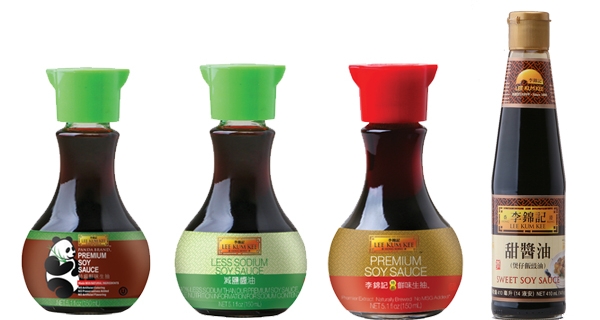
Common Types of Soy Sauce- The Most Widely Used Asian Ingredient
Regular Soy Sauce: A very familiar product in the West, regular soy sauce has become a staple in most American supermarkets. Used frequently in Asian cooking, regular soy sauce is a necessary staple in an Asian pantry. Most soy sauce varieties across Asia have the same consistency and salty flavor so there is no issue in substituting one brand for another. Asian grocery stores in the West carry a large variety of soy sauce brands while Western markets tend to feature Japanese brands such as Kikkoman. My personal favorite line of soy sauces is from the Lee Kum Kee brand as they have a large variety that includes low sodium options and different textures to be experimented with for home cooks already familiar with Asian cuisine.
Less Sodium Soy Sauce: This type of soy sauce is nearly identical to regular soy sauce except for the obvious- less sodium. Though traditionally, Asian cooks (in Asia) don’t use this product, there’s no reason why we can’t use a more health conscious version. Taste and color are nearly identical and for cooking purposes, there will be no noticeable difference. The only time that sensitive palates can tell a difference is when using less sodium soy sauce for a dipping sauce to sushi and sashimi. For those of us who are more health conscious though, this is a great alternative.
Dark Soy Sauce: For the purposes of Asian cooking, dark soy sauce can for the most part be interchanged with regular soy sauce. The main difference is that dark soy sauce is typically used for dipping sauces or cooking thicker stews. Dark soy sauce has a thicker consistency than regular soy sauce and a slightly more full bodied flavor. Sodium content in both is about the same. Some recipes call for the dark soy sauce mainly for coloring and texture.
Sweet Soy Sauce: Sweet soy sauce is another ingredient that is constantly found in Asian cooking. Much less salty than regular soy sauce, sweet soy sauce is thick like molasses and similarly black, with a rich sweetness. Used in both cooking and as the main ingredient in many sauces, several varieties of sweet soy sauce (Indonesia’s Kecap Manis, Thailand’s thick sweet soy sauce and the more widely available version from Lee Kum Kee) can be found in Asian markets. Sweet soy sauce is never a substitute for regular soy sauce and is not used as a salty ingredient in Asian cuisine but a sweetener.
Thick Soy Sauce: This variety of soy sauce is seldom featured in recipes for home cooking. Also sold as Dark Thick Soy Sauce, thick soy sauce is mostly used by restaurants for stir-fries, rice and noodles dishes. Thick soy sauce is widely used throughout Asia for its rich, thick consistency, which adds a nice velvety texture to the sauce in any stir-fry dish. Much less salty than regular soy sauce, it’s more closely associated with sweet soy sauce, but still less sweet than sweet soy sauce with a much thicker consistency.


 Welcome to Food, Travel & Life with The Asian Fusion Girl. Learn more about the AF Girl and her various projects
Welcome to Food, Travel & Life with The Asian Fusion Girl. Learn more about the AF Girl and her various projects




